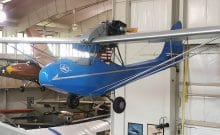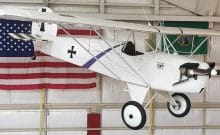About the de Havilland DHC-I Chipmunk
Designed by de Havilland Canada in 1946, the DHC-I Chipmunk is powered by an inverted inline 4 cylinder Gipsy Major 145 horsepower engine. The Chipmunk served as a military trainer for the Royal Canadian Air Force and British Royal Air Force, as well as a number of other countries including Portugal. This particular Chipmunk rolled out of the factory on October 27th, 1959, one of the last of sixty-six Chipmunks built under license in Portugal by OGMA (Officinas Gerais De Matereal Aeronautica). It was issued service number 1366.
FAP (Forca Aerea Portuguesa) trainees began their primary flight training in the Chipmunk. The first 20 hours were spent learning basic aircraft handling. For the next 10 hours, they performed “advanced maneuvers”, consisting of spins, loops, rolls, and basic formation flight. Trainees logged 30 to 40 hours in the Chipmunk before transitioning to the bigger, more powerful North American AT-6 “Texan”. Number 1366 accumulated approximately 2,800 hours of PAP flight time over the next 30 years, and was retired from service and placed into storage in 1989.
It was acquired in 1995 by the Aero Club de Portugal, and was sold the following year to Windmill Aviation in the United Kingdom. It was then exported to a private collector in the United States. Bill Sleeper acquired this airplane in 2002 as a disassembled collection of parts, and restored it over the course of the next four years. The majority of the restoration work was performed by Rich Zurinsky of Olalla, Washington. During that restoration, number 1366 was upgraded to incorporate disc brakes, modem magnetos, and an increased fuel capacity from nine imperial gallons per wing to twelve. Bill paid a personal visit to the OGMA museum in 2004 to examine their Chipmunk(s) to ensure that even the smallest details of the paint scheme would be correct on his restoration. Fittingly, Chipmunk number 1366 was issued FAA registration number NXI 366 when the restoration was completed.
The first flight after its restoration was in October 2006. Bill flew this airplane to various airshows and fly-ins around the Pacific Northwest for the next eleven years. He donated it to the Port Townsend Aero Museum collection in 2017.
| Engine | Gipsy Major 145 hp |
| Cruising speed | 100 mph |
| Empty weight | 1517 lbs |
| Gross weight | 2014 lbs |




